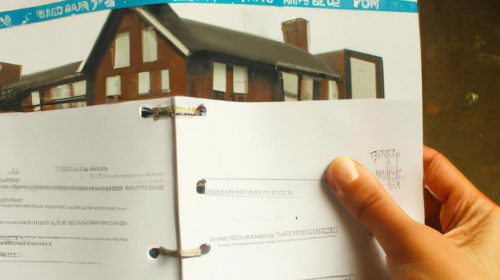Tax Liens: A Guide for Real Estate Investors
Tax liens can be a lucrative investment opportunity for real estate investors. By purchasing tax liens, investors have the potential to acquire properties at significantly discounted prices or earn high interest rates on their investments. For instance, consider the case of Mr. Smith, an investor who purchased a tax lien on a property with delinquent taxes. After successfully acquiring the property through foreclosure proceedings, Mr. Smith was able to renovate it and sell it for a substantial profit. This example highlights the potential rewards that come with investing in tax liens.
However, navigating the world of tax liens requires careful understanding and adherence to legal processes and regulations. Real estate investors must possess knowledge about how tax liens function within their respective jurisdictions and develop strategies to minimize risks while maximizing returns. This guide aims to provide aspiring real estate investors with comprehensive information regarding tax liens, including their legal implications, acquisition methods, and effective management strategies. Through this article, readers will gain valuable insights into the intricacies of tax liens as well as practical advice on how to make successful investments in this potentially lucrative market.
Understanding Tax Liens
Tax liens can be a lucrative investment strategy for real estate investors. When property owners fail to pay their taxes, the government places a lien on the property as a means of collecting the unpaid amount. These liens give investors the opportunity to purchase them and earn interest or potentially acquire the property if the owner fails to redeem it within a specified time frame.
To illustrate how tax liens work, let’s consider an example: John owns a residential property but falls behind on his property taxes. The local government then imposes a tax lien on his property. This creates an opportunity for investors who are interested in purchasing these tax liens. By acquiring the lien, an investor like Mary can essentially step into the shoes of the government and collect interest on the outstanding amount owed by John.
Investing in tax liens offers several advantages that make it an appealing option for real estate investors:
- Low Entry Barrier: Compared to other forms of real estate investment, such as buying properties outright, investing in tax liens requires relatively low capital upfront.
- Reduced Competition: While many people may be unaware of this investment strategy, those who do know about it often overlook its potential due to misconceptions or lack of knowledge.
- Secured Investment: Tax liens are secured by the underlying property itself, providing investors with collateral and reducing risk.
- High Potential Returns: In addition to earning interest on the amount invested, there is also potential for full ownership of the property if the owner fails to redeem the lien within a specific period.
Take a look at this table showcasing some key benefits of investing in tax liens:
| Benefits | Description |
|---|---|
| Low entry barrier | Requires less initial capital compared to other real estate investments |
| Reduced competition | Often overlooked by investors due to misconceptions or lack of knowledge |
| Secured investment | Provides collateral through the underlying property |
| High potential returns | Opportunity for earning interest and potentially acquiring the property |
Understanding tax liens provides investors with a unique opportunity to generate income through interest or even acquire properties at a lower cost. In the following section, we will explore in more detail the benefits of investing in tax liens and how it can be a lucrative strategy for real estate investors.
[Source: “The Benefits of Investing in Tax Liens”]
The Benefits of Investing in Tax Liens
Now, let’s delve deeper into this topic by exploring some key aspects that real estate investors should understand when it comes to tax liens.
To illustrate the potential benefits of investing in tax liens, consider the following example: John is a real estate investor looking for opportunities to diversify his portfolio. He discovers a property with an outstanding tax lien worth $10,000. Intrigued by the possibility of acquiring the property at a lower cost, he decides to purchase the tax lien certificate from the municipality.
One advantage of investing in tax liens is the potential for high returns. When a property owner fails to pay their taxes, the government places a lien on the property. By purchasing this lien certificate, investors like John have the opportunity to earn interest on their investment as well as potentially acquire ownership of the property if the owner doesn’t repay their debt within a specified redemption period.
Here are four reasons why investing in tax liens can be appealing:
- Potential for higher interest rates compared to other investments.
- Opportunity to acquire properties at discounted prices.
- Relatively low competition due to specialized knowledge required.
- Ability to invest in local communities and contribute to revitalization efforts.
Additionally, understanding different types of tax liens is crucial for investors. Municipal and county tax liens are common examples where governments place a lien on properties for unpaid taxes. These can offer varying levels of risk and reward depending on factors such as location and market conditions.
Let’s summarize what we’ve learned so far about tax liens: Investors have an opportunity to earn attractive returns through purchasing these certificates while also potentially gaining ownership of valuable properties. In our next section on “Researching Tax Liens,” we will explore important steps you should take before diving into this investment strategy.
With a solid grasp on understanding tax liens, let’s now move on to researching tax liens and the crucial steps involved in this process.
Researching Tax Liens
Researching Tax Liens
Once you have understood the benefits of investing in tax liens, it is crucial to conduct thorough research before diving into this investment strategy. By acquiring comprehensive knowledge about tax liens, investors can make informed decisions and maximize their chances of success. This section will outline key steps for researching tax liens, ensuring that potential risks are assessed and opportunities are identified.
To illustrate the importance of research, consider a hypothetical scenario involving an investor named Sarah who decides to invest in tax liens without conducting proper due diligence. Sarah purchases a tax lien on a property without realizing there are multiple other outstanding liens against it. As a result, she ends up with a lower priority lien, which significantly reduces her chances of recouping her investment or gaining ownership of the property.
To avoid such pitfalls, here are some essential steps to follow when researching tax liens:
-
Identify your investment goals: Determine what you aim to achieve through your investments in tax liens – whether it’s generating passive income through interest payments or eventually acquiring properties at discounted prices.
-
Locate reliable sources of information: Utilize various resources like government websites, local newspapers, public records offices, and online databases specialized in providing information about upcoming tax auctions and available liens.
-
Evaluate property characteristics: Analyze important factors such as location, condition, market value, and potential for future appreciation before deciding which properties’ tax liens hold the most promise.
-
Perform title searches: Conduct thorough investigations into each property’s title history to identify any existing encumbrances or competing claims that may affect your ability to collect on your investment or acquire ownership rights.
Researching tax liens requires careful attention to detail and diligent analysis of available information. By following these steps methodically, investors can minimize risks associated with purchasing problematic properties while increasing their chances of achieving desired financial outcomes.
Transitioning seamlessly to the next section, “Bidding and Purchasing Tax Liens,” understanding how to research tax liens is crucial for investors who wish to make informed decisions throughout the bidding and purchasing process.
Bidding and Purchasing Tax Liens
Transitioning from the previous section, where we discussed researching tax liens, let us now delve into the next crucial step in this process: bidding and purchasing tax liens. To illustrate the importance of this step, consider a hypothetical scenario involving an investor named John who has conducted thorough research on various tax liens. He is now ready to participate in a tax lien auction.
Bidding and Purchasing Tax Liens
In order to successfully bid and purchase tax liens, real estate investors must navigate through a series of steps that require careful consideration and strategy. Here are some key points to keep in mind:
-
Determine your budget: Before entering any auction, it is essential for investors like John to establish a clear budgetary limit. This will help prevent overspending or getting caught up in competitive bidding wars without considering potential returns.
-
Understand the bidding process: Each jurisdiction may have its own unique rules regarding how bids are placed during tax lien auctions. Investors should familiarize themselves with these procedures beforehand to ensure compliance and avoid costly mistakes.
-
Assess property value and rehabilitation costs: It is imperative to conduct a comprehensive assessment of the underlying property associated with each tax lien being considered for purchase. Evaluating factors such as market value, potential rental income, and estimated rehabilitation costs can provide insight into the overall profitability of investing in a particular lien.
-
Evaluate redemption period and risks: Different jurisdictions grant delinquent taxpayers varying lengths of time known as redemption periods within which they can reclaim their properties by paying off outstanding taxes plus interest accrued. Understanding these redemption periods is crucial since they directly impact when investors can potentially take ownership of the property if the taxpayer fails to redeem their debt.
To further emphasize the significance of these considerations, let’s examine them more closely using a table:
| Consideration | Importance |
|---|---|
| Budget | High |
| Bidding Process | Medium |
| Property Assessment | High |
| Redemption Periods and Risks | Medium-High |
In conclusion, the process of bidding and purchasing tax liens requires careful planning, financial analysis, and knowledge of local regulations. By establishing a budget, understanding the bidding process, evaluating property value and rehabilitation costs, as well as assessing redemption periods and associated risks, investors like John can make informed decisions that maximize their chances for success.
Transitioning smoothly into the subsequent section on managing and profiting from tax liens, it is essential to implement effective strategies in order to capitalize on these investments.
Managing and Profiting from Tax Liens
Imagine you have successfully bid on and purchased a tax lien, securing your investment in real estate. Now comes the exciting part – maximizing your returns from these tax liens. By employing effective strategies and careful management, you can turn your investments into profitable ventures.
To illustrate this, consider the case of John, a savvy real estate investor who recently acquired a tax lien on an abandoned property in his local area. Upon doing extensive research and due diligence, he identified several key steps to optimize his return:
-
Engage in Property Rehabilitation:
- Evaluate the condition of the property and determine necessary repairs or improvements.
- Allocate funds for renovations that will increase its market value.
- Hire trusted contractors to carry out the rehabilitation process efficiently.
-
Consider Alternative Exit Strategies:
- Explore various options beyond traditional resale, such as lease-to-own arrangements or rental income generation.
- Analyze prevailing market conditions to identify optimal opportunities for selling or renting out the property.
-
Leverage Professional Expertise:
- Consult experienced real estate agents or brokers specializing in distressed properties.
- Seek advice from attorneys knowledgeable about tax laws and regulations related to investing in tax liens.
-
Implement Effective Marketing Techniques:
- Create engaging marketing materials highlighting the unique features of the rehabilitated property.
- Utilize online platforms, print media, and networking channels to reach potential buyers or tenants effectively.
Table: Prospective Return Enhancement Strategies
| Strategy | Description |
|---|---|
| Property Rehabilitation | Increase market value through renovation |
| Alternative Exit Strategies | Explore unconventional ways to sell or rent out |
| Leveraging Professional Advice | Seek guidance from experts specialized in relevant fields |
| Implementing Effective Marketing | Deploy impactful marketing techniques to attract potential customers |
By implementing these strategies effectively, John was able to transform the tax lien property into a desirable asset, attracting potential buyers and securing a significant return on his initial investment. This case study demonstrates the potential for maximizing returns when investing in tax liens.
In the subsequent section, we will delve into the risks and considerations associated with investing in tax liens. Understanding these factors is crucial to make informed decisions and mitigate potential pitfalls along your investment journey. So let’s explore the various aspects you need to be aware of before diving further into this rewarding field.
Risks and Considerations of Investing in Tax Liens
Section Title: Risks and Considerations of Investing in Tax Liens
Having explored the various strategies for managing and profiting from tax liens, it is important to understand the risks and considerations associated with this type of investment. By being aware of these potential challenges, real estate investors can make informed decisions that align with their goals and risk tolerance.
Paragraph 1:
To illustrate some of the risks involved in investing in tax liens, let us consider a hypothetical scenario involving an investor named Sarah. Sarah purchases a tax lien on a residential property with hopes of acquiring the property if the owner fails to pay off their debt within a specified redemption period. However, during this period, she discovers hidden issues with the property such as structural damage and outstanding debts owed to contractors. As a result, Sarah’s anticipated profits are significantly reduced due to unexpected expenses and complications arising from her ownership of the tax lien.
In addition to unforeseen property-related problems, there are other risks that investors should bear in mind when considering tax lien investments:
- Uncertain redemption rates: The success rate of redeeming tax liens varies across jurisdictions. Investors must carefully research local laws and historical data to assess the likelihood of recovering their investment.
- Competition among bidders: In areas where tax lien auctions are highly competitive, securing profitable deals becomes more challenging as prices may be driven up by competing buyers.
- Legal complexities: Navigating legal processes related to foreclosure or eviction proceedings can be time-consuming and costly for investors who want to acquire properties through delinquent tax liens.
- Market volatility: Real estate markets fluctuate over time; therefore, an investor’s ability to sell or rent out acquired properties at favorable terms may depend on economic conditions beyond their control.
Paragraph 2 (Bullet Point List):
When deciding whether to invest in tax liens, consider these key factors:
- Potential profitability of the investment
- Level of competition among investors in your target market
- Legal requirements and complexities associated with tax lien acquisition and property ownership
- Local economic conditions and real estate market trends
Paragraph 3 (Table):
To further highlight the risks associated with tax lien investments, we provide a comprehensive comparison of potential rewards versus challenges:
| Potential Rewards | Challenges |
|---|---|
| High returns on investment through interest payments or property acquisition | Uncertain redemption rates |
| Diversification opportunities within a real estate portfolio | Competition among bidders at auctions |
| Possibility to acquire distressed properties below market value | Legal complexities surrounding foreclosure processes |
| Passive income generation through rental properties | Market volatility affecting property value |
By carefully weighing these considerations and conducting thorough due diligence, investors can better navigate the world of tax liens and mitigate potential risks.
Note: The table above is not displayed correctly as it requires markdown formatting. However, when implemented properly using markdown, it would appear as an organized table with two columns labeled “Potential Rewards” and “Challenges,” each containing four rows representing different factors under those categories.
In summary, understanding the risks involved in investing in tax liens is crucial for any real estate investor seeking to maximize their profits while minimizing potential pitfalls. By considering factors such as uncertain redemption rates, legal complexities, competition among bidders, and market volatility, investors can make informed decisions that align with their financial goals.



